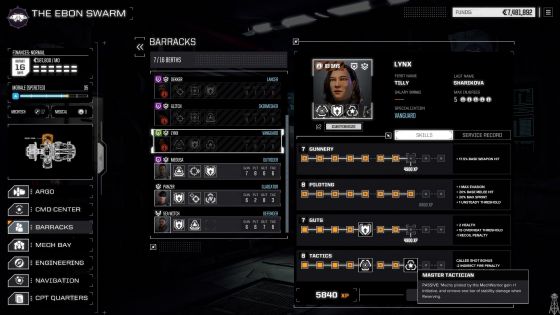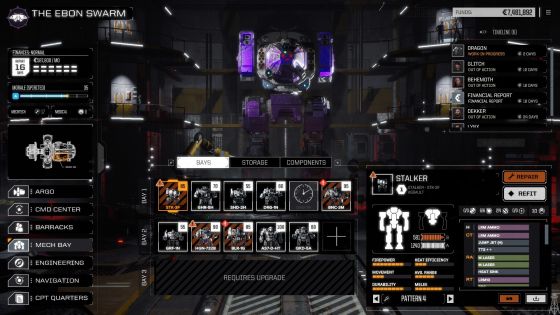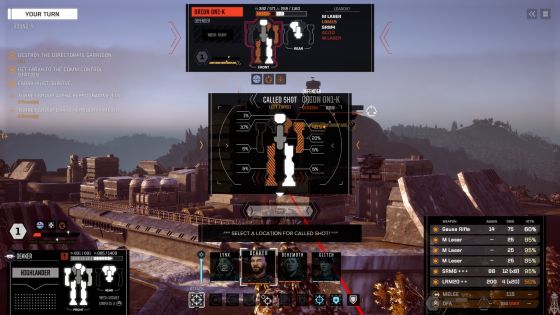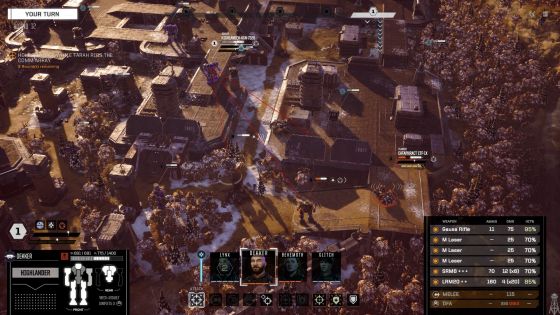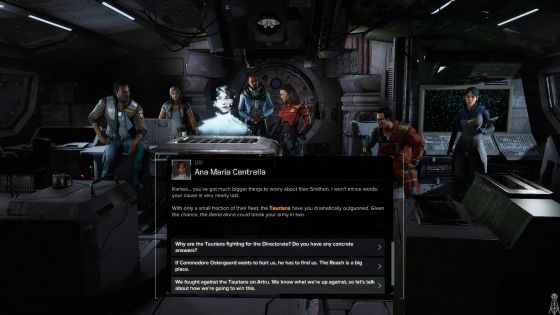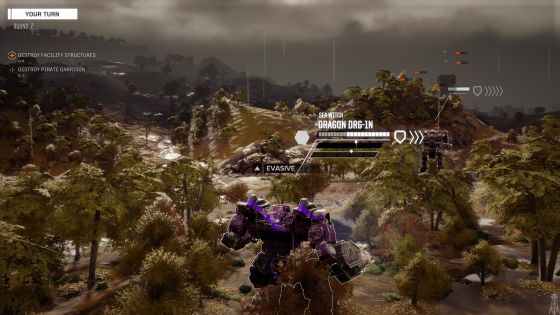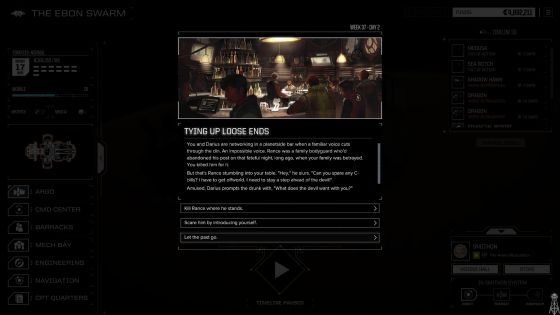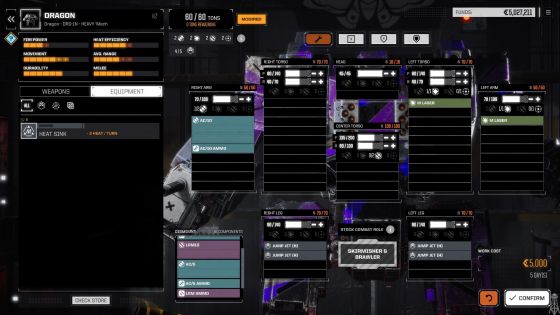Battletech Review

When I was studying at the university, I played a lot of tabletop games. One of those was Battletech. There was nothing more fun than playing giant robots with a variety of weapons and blowing the heck out of your opponent. Of course, the game wouldn't have been any fun if Battletech wasn't a well-designed tactics game, where not only the experience of your mechwarrior, but the speed, armaments, size, and durability of each individual robot (or battlemech) played a role. Having a classic tactics game as the basis of a computer game is a good thing, but it doesn't ensure a good game. Even implementing great mechanics isn't alone a game, especially not for single players, who aren't playing to have fun with their friends, but who want an interesting variable campaign. Battletech is actually two interwoven games. On the one hand you play a story campaign. On the other there is a sandbox game, where you travel and take procedurally generated missions. The two games are interwoven, but sadly not equally good.
Mechanics
If anyone questions whether Battletech is an RPG, I can only answer thus: If you consider X-Com, the Valkyria Chronicles, Heroes of Might and Magic, or Battle Brothers an RPG, then Battletech can certainly qualify as one. It has characters, a story, dialogue, character development, and meaningful mechanical choices. Like these games though most of the gameplay is delivered in missions involving a tactical battle, which often has multiple phases.
You control a group of mechwarrior mercenaries, who are basically an elite group of robot pilots. You get to make your own at the beginning and start with four companions. You can hire more later. Each companion has four stats, rated from 2 to 10. The first two stats that reach 5 give you a special ability. So if your warrior reaches 5 first in tactics and gunnery, they get special abilities in tactics and gunnery, but can never get one in guts or piloting. Also the first stat to hit 8 also grants one advanced ability.
Though your pilots only have 4 attributes, the special abilities you can gain make planning out your advancement important.
That may seem pretty basic, but the most important mechanical choice in Battletech is your pilot's choice of mech. The faster a mech is the more it can move and the harder it can be to hit. But moving fast means less place for armor and weapons. And Battletech has a huge variety of weapons, each with their own range, damage, and heat generation. If a Battlemech generates too much heat they can shut down or take internal damage. Weapons can be generally divided into missiles, cannons, and energy weapons, each with their own advantages and disadvantages. Missiles can fire on targets outside of line of sight, and hit in salvos, normally hitting multiple locations, which means more chances for critical hits. Energy weapons are lightweight and don't depend on ammunition but generate tons of heat. Cannons are very heavy but generate little heat and generally do lots of damage to a single location, which gives a better chance for piercing armor and hitting something vital. That means each individual mech can be very different. They also can be customized to a certain extent in your mechbay, provided you have the time, parts and money. Customizing your mechs can be fun, but sometimes its also necessary, as your mech's weapons can be destroyed in combat.
In the mechbay you can view, repair, or further customize your mechs.
Combat
The core of Battletech is a very well-designed combat system which follows the tabletop game quite well. Your success in combat depends on a variety of factors, such as positioning your mechs so that they have line of sight, are in range to fire optimally on enemies, and fire just enough of their weapon systems to manage heat as well as ammunition, and deal maximum damage. Also, you need to protect your mechs by hiding them in and behind terrain, and to move them so that they have the best defence, and so that none of the four mechs you take in combat will be destroyed. And yes, the computer AI will go after weakened and vulnerable mechs, so consider yourself warned. Like all tabletop games, Battletech combat has a degree of randomness. You always see your chance of hitting with your various weapon systems before your fire, though.
Downed enemies are subject to called shots. Targeting and destroying the center torso is the fasted way to disable a mech. But destroying both legs yields more salvage, but that means destroying two locations. Destroying the head also grants more salvage, but actually hitting it is pretty difficult.
Battletech combat is well designed and thrilling, but also time consuming. Missions can last 20-50 minutes. There is a lot of thinking involved and moving your units wrong can prove fatal. Also, the very complex combat is not in its entirety made clear in the tutorial. Small things, like that jumping adds an evasion bonus, or that very short ranged weapons like machine guns fire when charging an enemy mech are things that any player of the tabletop knows, but a computer gamer new to the game will have to pick up. The developers do a good job trying to present this information, but there are so many fine points in Battletech, that I think its probably a big learning process for a new player to internalize everything. On the other hand, when you have internalized the game's rules it becomes apparent the myriad options open to you in combat.
Battletech does an excellent job of showing line of sight and hit chances, so its usually clear what the optimal firing range is, who is a possible target, and where your mech is in most danger.
Each map has a variety of terrain. Fighting in deserts means it is harder to dissipate heat. In the tundra its quite the opposite. Standing in water is also good to get rid of heat but means standing without much cover. Hiding behind a hill or building can block enemy line of sight, while forests offer cover from enemy fire. My most memorable battle was late in the game, where my four battlemechs spent most of the battle in a lake in a badlands, dissipating a lot of heat and firing most of their weapon systems at the cost of cover and movement, while my opponents stayed in the hills, where they had cover, but suffered from the stifling heat of the badlands.
The Campaign
The cut scenes in Battletech are reminicent of comic book panels with spoken narration.
Battletech features a story campaign. You create your own mechwarrior, and you are enlisted to help Kamea Arano regain her throne. But Kamea isn't the only NPC of importance. Yang is your chief engineer. Darius helps find you jobs and tells you what to expect during missions, and Sumire is the pilot who flies your team in and out of missions. They all comment on what's going on during the campaign, and you can also talk with them at leisure, should you choose. Your fellow mechwarriors are less well defined. Each has a decent voice actor and broad characteristics, sort of like the mercenaries from Jagged Alliance 2. Their personalities are further defined by random vignettes, like you can find in Battle Brothers or the Expedition games and depending on what you decide these can have small bonuses or penalties in game. Unfortunately, like those games these begin to repeat as a playthrough commences. In my 40+ hour playthrough I saw a number of these random vignettes twice.
You can say a lot of different things during the story, some of which even depends on your background, but whatever you say has little actual impact on the gameplay.
The story campaign is in general well written. It is depicted with illustrated cut scenes and voiced narration. The game features branching dialogue where you can decide your main character's personality. Depending on the background you choose for your main character, you'll gain extra dialogue choices. Nevertheless, there isn't much actual choice in the story campaign. Whether you are a greedy bastard or a good-hearted and dutiful won't change the fact that you will play out each of the missions in a set order.
The writing, story, and characters are well written.
The missions themselves are excellently designed. This is where the game really shines. The campaign maps often have interesting terrain and conditions. In general, the missions fit in well to the story. Most of them have multiple goals and some of them need to be accomplished within a set number of combat rounds. You will also face a wide variety of enemies in these missions. Not only will you fight mechs, but also turrets, artillery, and vehicles. Some missions take interesting twists part way through, keeping you on your toes.
The way the campaign missions are designed make each of them interesting. Here we are given a risk-reward situation. The more ammo we save, the more money we earn, but playing it safe means risking less damage and avoiding failure.
The Sandbox Game
In Battletech you have a base, pilots, and mechs. Mechs need to be repaired. Pilots can get injured and need medical attention. They also are mercenaries who need to get regularly paid. In addition, you need to fly to missions, which takes time. So, in short you need money, and good facilities. You can improve your facilities to reduce travel time, improve healing, and reduce repair time, but that also costs money. During the course of the campaign you are straight out given a few new mechs and are given the opportunity to buy more. Early on you get the chance to buy Griffin and a Dragon mechs, then for a long time you are given no opportunities in the campaign to buy anything.
To get new mechs you need to collect salvage. Normally when you destroy a mech until 1/3th of it remains. If you get lucky and destroy the head or both legs, there might be more. Destroying a head is very difficult. Destroying the legs is easier, but often not the fastest way to down an opponent, and so one always has to weigh whether its worth trying to collect more salvage at the risk of losing one's own mechs or pilots. If you get 3 pieces of the exact same mech type you can piece them together and get a new mech. This is the easiest way to get a new mech. However, it should be noted that you often only get 1-3 pieces of salvaged mech per battle. If you take 3 pieces, then you are passing up cash which you may need to make repairs and pay salaries. You also may find a place to buy a new mech by travelling around. However, this takes a lot of time in which you are not earning income and still compounding expenses.
In comparison to the complex campaign mission above, this is a typical sandbox mission. We need to find a base and destroy 4 of its buildings. These missions are all very straightforward, and after you have played them once, they play out roughly the same, despite different terrain and enemy mechs.
I explain all this because there is a long time in between campaign missions and eventually the Dragon and Griffin mechs no longer seem satisfactory, so I at least felt compelled to travel around and take missions in between the story missions.
The problem here is that in comparison with the campaign missions, the procedurally generated missions in the sandbox game are quite simple and repetitive. Each individual mission is fun the first time you play it. But generally, they can be boiled down to reaching a specific spot on a map and destroying something there. And then a second wave of enemy reinforcements arrive. Sure, the environment can vary, and the mechs you face are randomly determined based on the mission's difficulty. So here we have a tradeoff of grinding increasingly uninteresting procedural missions against the thrill of acquiring a new mech which has a different playstyle and may be a substantial improvement over one's current mechs.
Only the campaign mode kept me going through the game till the end. And I did do a number of optional missions to get new mechs, but only to get me through the game. The sandbox mode alone was maybe fun for me for the first 10 missions or so. It took my 40 hours to play through battle tech. I'm guessing 1/3th of my missions were story missions, while the rest were procedurally generated sand box missions
This is a story vignette directly related to the background I selected for my character, which is a nice twist.
It should be noted that Battletech has a skirmish mode in which you can pit a team of hand selected mechs against an opponent for exactly one battle. This lets you play with any of the game's mechs, many of which you will only face in the campaign as opponents.
State of the Game
Like many modern games Battletech launched with some problems. Players complained about long loading times, long combat animations, and other bugs. I'm not sure if the combat animations were once longer than they are now. You can turn them off, but I didn't bother as they didn't seem overly long to me. I didn't run into any bugs at all during my playthrough. The initial loading time when starting the program is quite long. The only game which has managed to rival it on my current new computer is Pathfinder. Once the game starts though, I found loading times acceptable, if not short.
For those who like mechanical complexity the ability to customize a mech can be a fun way to test out the game's tactical possibilities. However, its completely optional as the standard mech designs are good enough to carry one through the campaign.
Summary
Battletech is one of those games where I find it hard to give a rating. The campaign is very good. The sandbox game is maybe good. So I'm giving it a good, but in my eyes it's a very high good. Getting past that, I'd say Battletech is definitely worth one playthrough if you like the setting. The combat mechanics are superb, if you don't mind complex mechanical systems. The campaign is well designed and fun. You just have to slug through some sandbox missions. And to be fair the campaign missions weren't extremely hard and with the four assault mechs I had at game's end I had little trouble in the end game, and so it probably wasn't really necessary for me to chase down as many extra mechs as I did to complete the campaign. So, you're not really required to do all that many sandbox missions if you don't want to. It's still a shame that the sandbox missions are so generic. The designers could have created a superb game with more variety and better designed missions in the sandbox game. Nevertheless, Battletech is an entertaining SRPG with an unusual setting.
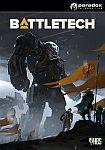
Information about
BattleTechDeveloper: Harebrained Schemes
SP/MP: Single-player
Setting: Sci-Fi
Genre: Tactical RPG
Combat: Turn-based
Play-time: Unknown
Voice-acting: Unknown
Regions & platforms
World
· Platform: PC
· Released: 2018-04-24
· Publisher: Harebrained Schemes
More information
Other articles
Summary
Pros
- Excellent mission design (campaign)
- Implementation of great tabletop mechanics
- Good story (campaign)
- Tons of tactical options in combat
Cons
- Repetitive and simple mission design (sandbox)
- Some long loading times
- Campaign dependent on sandbox missions
- Tutorial barely covers the vast mechanical complexities


